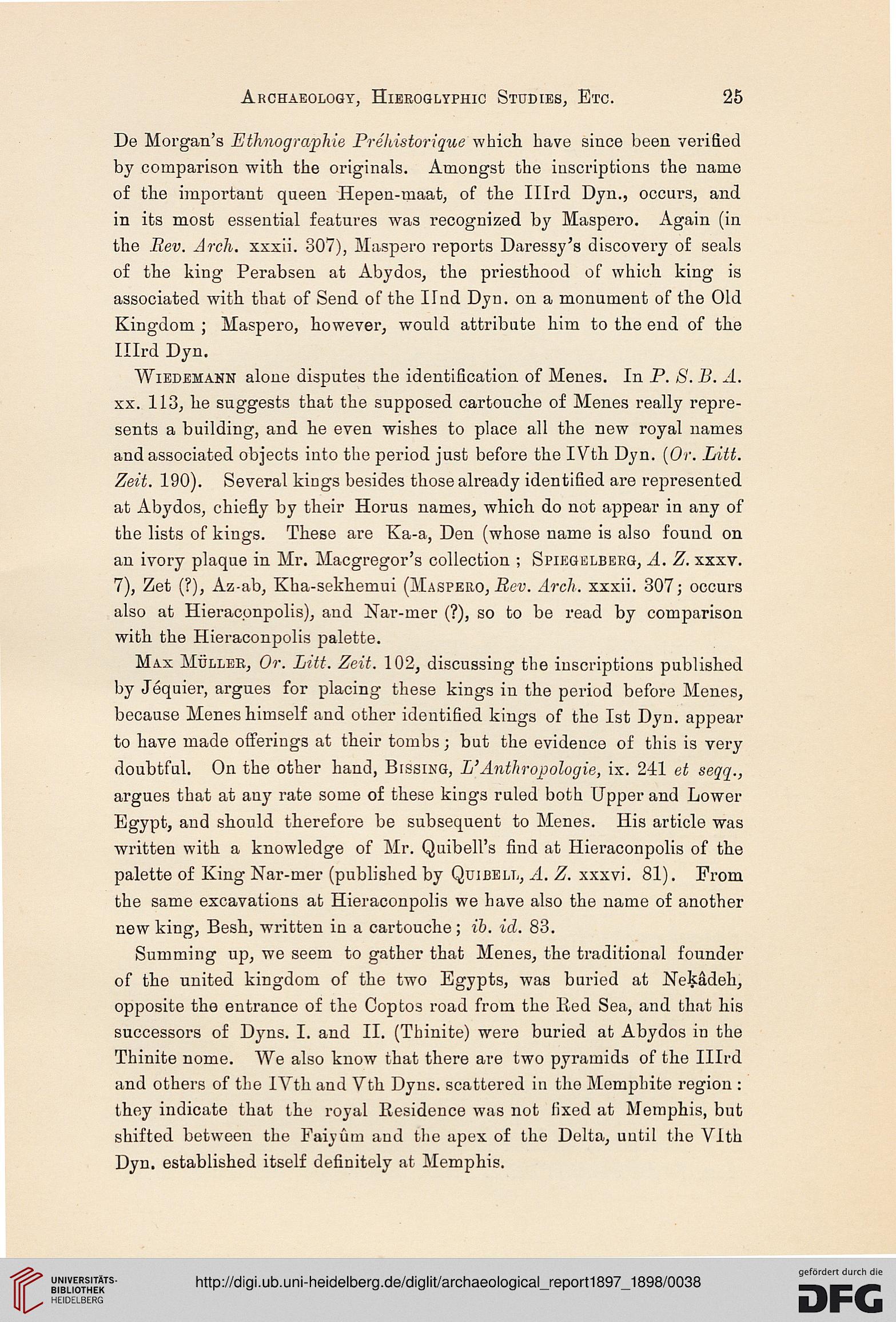Archaeology, Hieroglyphic Studies, Etc.
25
De Morgan's Ethnographie Preliistorique which have since been verified
by comparison with the originals. Amongst the inscriptions the name
of the important queen Hepen-maat, of the Illrd Dyn., occui's, and
in its most essential features was recognized by Maspero. Again (in
the Rev. Arch, xxxii. 307), Maspero reports Daressy's discovery of seals
of the king Perabsen at Abydos, the priesthood of which king is
associated with that of Send of the Ilnd Dyn. on a monument of the Old
Kingdom ; Maspero, however, would attribute him to the end of the
Illrd Dyn.
Wiedemann alone disputes the identification of Menes. In P. S. B. A.
xx. 113, he suggests that the supposed cartouche of Menes really repre-
sents a building, and he even wishes to place all the new royal names
and associated objects into the period just before the IVth Dyn. (Or. Litt.
Zeit. 190). Several kings besides those already identified are represented
at Abydos, chiefly by their Horus names, which do not appear in any of
the lists of kings. These are Ka-a, Den (whose name is also found on
an ivory plaque in Mr. Macgregor's collection ; Spiegelberg, A. Z. xxxv.
7), Zet (?), Az-ab, Kha-sekhemui (Maspero, Rev. Arch, xxxii. 307; occurs
also at Hieracpnpolis), and Nar-mer (?), so to be read by comparison
with the Hieraconpolis palette.
Max Mulleb, Or. Litt. Zeit. 102, discussing the inscriptions published
by Jequier, argues for placing these kings in the period before Menes,
because Menes himself and other identified kings of the 1st Dyn. appear
to have made offerings at their tombs; but the evidence of this is very
doubtful. On the other hand, Bissing, L'Anthropologic, ix. 241 et segq.,
argues that at any rate some of these kings ruled both Upper and Lower
Egypt, and should therefore be subsequent to Menes. His article was
written with a knowledge of Mr. Quibell's find at Hieraconpolis of the
palette of King Nar-mer (published by Quibell, A. Z. xxxvi. 81). Prom
the same excavations at Hieraconpolis we have also the name of another
new king, Besh, wrritten in a cartouche; ib. id. 83.
Summing up, we seem to gather that Menes, the traditional founder
of the united kingdom of the two Egypts, was buried at Nekadeh,
opposite the entrance of the Coptos road from the lied Sea, and that his
successors of Dyns. I. and II. (Thinite) were buried at Abydos in the
Thinite nome. We also know that there are two pyramids of the Illrd
and others of the IVth and Vth Dyns. scattered in the Memphite region :
they indicate that the royal Residence was not fixed at Memphis, but
shifted between the Faivum and the apex of the Delta, until the Vlth
Dyn. established itself definitely at Memphis.
25
De Morgan's Ethnographie Preliistorique which have since been verified
by comparison with the originals. Amongst the inscriptions the name
of the important queen Hepen-maat, of the Illrd Dyn., occui's, and
in its most essential features was recognized by Maspero. Again (in
the Rev. Arch, xxxii. 307), Maspero reports Daressy's discovery of seals
of the king Perabsen at Abydos, the priesthood of which king is
associated with that of Send of the Ilnd Dyn. on a monument of the Old
Kingdom ; Maspero, however, would attribute him to the end of the
Illrd Dyn.
Wiedemann alone disputes the identification of Menes. In P. S. B. A.
xx. 113, he suggests that the supposed cartouche of Menes really repre-
sents a building, and he even wishes to place all the new royal names
and associated objects into the period just before the IVth Dyn. (Or. Litt.
Zeit. 190). Several kings besides those already identified are represented
at Abydos, chiefly by their Horus names, which do not appear in any of
the lists of kings. These are Ka-a, Den (whose name is also found on
an ivory plaque in Mr. Macgregor's collection ; Spiegelberg, A. Z. xxxv.
7), Zet (?), Az-ab, Kha-sekhemui (Maspero, Rev. Arch, xxxii. 307; occurs
also at Hieracpnpolis), and Nar-mer (?), so to be read by comparison
with the Hieraconpolis palette.
Max Mulleb, Or. Litt. Zeit. 102, discussing the inscriptions published
by Jequier, argues for placing these kings in the period before Menes,
because Menes himself and other identified kings of the 1st Dyn. appear
to have made offerings at their tombs; but the evidence of this is very
doubtful. On the other hand, Bissing, L'Anthropologic, ix. 241 et segq.,
argues that at any rate some of these kings ruled both Upper and Lower
Egypt, and should therefore be subsequent to Menes. His article was
written with a knowledge of Mr. Quibell's find at Hieraconpolis of the
palette of King Nar-mer (published by Quibell, A. Z. xxxvi. 81). Prom
the same excavations at Hieraconpolis we have also the name of another
new king, Besh, wrritten in a cartouche; ib. id. 83.
Summing up, we seem to gather that Menes, the traditional founder
of the united kingdom of the two Egypts, was buried at Nekadeh,
opposite the entrance of the Coptos road from the lied Sea, and that his
successors of Dyns. I. and II. (Thinite) were buried at Abydos in the
Thinite nome. We also know that there are two pyramids of the Illrd
and others of the IVth and Vth Dyns. scattered in the Memphite region :
they indicate that the royal Residence was not fixed at Memphis, but
shifted between the Faivum and the apex of the Delta, until the Vlth
Dyn. established itself definitely at Memphis.





